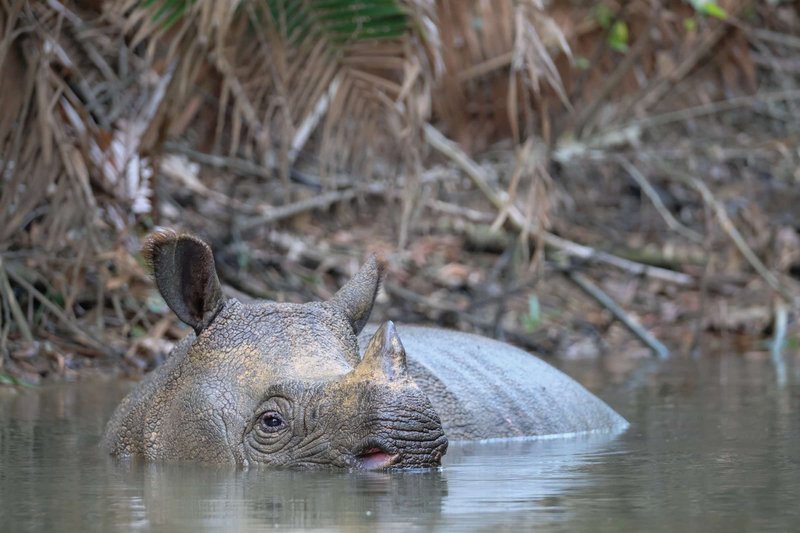
The Javan rhinoceros, with its thick skin and impressive stature, might seem like a gentle giant, but they are wild animals. Being prepared can make all the difference, both for your safety and for the rhino’s wellbeing. So, let’s dive into what you should do if you catch sight of one of these rare beasts during your adventures.
Understanding the Javan Rhinoceros
Before we jump into action steps, let’s take a minute to appreciate the Javan rhinoceros. These animals are among the most elusive rhino species and are known to inhabit dense forests and jungles. They can weigh up to 2,200 pounds and sport a single horn, which might be intimidating, but they are generally shy and prefer to avoid human interaction.
Here’s the thing: the Javan rhinoceros is on the brink of extinction, with fewer than 80 individuals left in the wild. That’s less than the number of people you might invite to a small dinner party! Knowing that they are rare and endangered adds a layer of responsibility to how we approach them in the wild.
It’s essential to understand their behavior. Unlike their African cousins, Javan rhinos often hide in thick vegetation and are not known for aggressive behavior unless they feel threatened. So, if you encounter one, remember that sudden movements or loud noises might startle them.
Stay Calm and Observe
Your first instinct might be to take a picture, but let’s hit pause on that thought. If you see a Javan rhinoceros, your first move should be to remain calm. Take a deep breath, and give yourself a moment to gather your thoughts.
Why is staying calm important? When you’re composed, you’re less likely to make sudden movements, which can alarm the rhino. Instead, focus on observing its behavior. Is it grazing? Is it moving cautiously? Understanding its actions can help you figure out your next steps.
Find a safe spot where you have a clear view of the rhino without being too close. Use any available cover, like bushes or trees, to keep your distance. Watching a Javan rhinoceros in its natural habitat can be a magical experience, but remember: your safety comes first.
Keep Your Distance
When you encounter a Javan rhinoceros, distance is your best friend. Ideally, you want to maintain a safe distance of at least 100 meters (about 328 feet). This distance allows you to observe the rhino while minimizing any potential danger.
Here’s a quick breakdown of why keeping your distance matters:
- Safety: Rhinos can charge if they feel threatened—staying far away reduces the chances of surprising them.
- Respect for Wildlife: Observing from a distance ensures that you don’t intrude on their natural behavior.
- Better Experience: With distance, you can observe the rhino’s actions without the pressure of a close encounter.
If the rhino starts moving in your direction, it’s crucial to stay still. Running can trigger a chase response, and you certainly don’t want to invoke that kind of behavior. Just keep calm and allow the rhino to pass.
Know When to Retreat
If the Javan rhinoceros seems agitated or starts moving toward you, it’s time to think about retreating. But here’s the thing: you don’t want to turn your back on the rhino or run away. Instead, back away slowly while keeping your eyes on the animal.
Strongly consider these factors when deciding to retreat:
- Body Language: If the rhino is snorting, stomping, or flaring its nostrils, it might be feeling threatened. Those are signs it’s time to leave.
- Position: Make sure you have a clear path to retreat without stumbling or tripping over obstacles.
- Stay Quiet: Avoid making noise as you back away. Sudden sounds can provoke the rhino further.
Retreating calmly shows the rhino that you mean no harm. Once you’re at a safe distance, you can breathe a sigh of relief and reflect on the incredible encounter.
Documenting the Encounter Safely
If all goes well and you’ve managed to observe the Javan rhinoceros from a safe distance without startling it, you might want to document the encounter. Photography or note-taking can help you remember this awe-inspiring moment.
When you do decide to take pictures or notes, follow these tips:
- Use a Zoom Lens: If you’re taking pictures, use a zoom lens to capture the rhino without getting too close.
- Be Discreet: Keep your movements slow and quiet to avoid drawing attention to yourself.
- Don’t Disturb: Make sure your photography doesn’t interfere with the rhino’s natural habits.
By documenting the encounter responsibly, you not only preserve the memory but also contribute to awareness about endangered species like the Javan rhinoceros.
Report Your Sighting
After your incredible experience, consider reporting your sighting to local wildlife authorities. This information can be valuable for conservation efforts. Javan rhinoceros populations are monitored closely, and every sighting helps in understanding their movements and habitat needs.
When you report, provide details like:
- Location: Where did you see the rhino? Exact coordinates are helpful if you can provide them.
- Time: What time of day was it?
- Behavior Observed: How was the rhino acting? Was it eating, resting, or moving?
Your input might seem small, but it can contribute significantly to the preservation of these magnificent creatures.
Practice Responsible Wildlife Viewing
Finally, the best way to ensure safe encounters with Javan rhinoceroses—and wildlife in general—is to practice responsible viewing. Committing to ethical wildlife watching allows us to appreciate these animals without endangering them.
Here’s how you can be a responsible observer:
- Follow Guidelines: Always adhere to local guidelines for wildlife viewing. They’re there for a reason!
- Educate Others: Share your knowledge about the Javan rhinoceros and the importance of conservation.
- Stay Informed: Keep learning about endangered species and the ecosystems they inhabit.
Being respectful and responsible as a wildlife observer helps ensure that future generations can also enjoy the beauty of the Javan rhinoceros.
In conclusion, knowing what to do if you encounter a Javan rhinoceros in the wild can transform an extraordinary experience into a safe and memorable one. From staying calm and keeping your distance to documenting your sighting responsibly and practicing ethical viewing, these steps can help protect both you and this incredible species. So, the next time you find yourself in the heart of the jungle, remember these tips—and enjoy the breathtaking beauty of nature!

